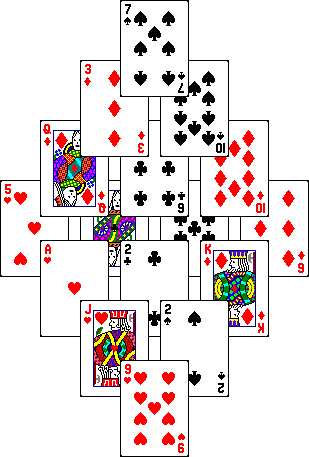
|
|
| |||

| Players: | 2 (with 3 player variant) | |
| Average Duration: | 15 minutes | |
| Equipment: | 1 deck of cards | |
| Object: | To be the first to reach 11 points by playing cards in such a way that your opponent cannot. |
|
|
Play consists of several rounds until one player gets 11 or more points and, therefore, wins the game. If both players become tied at 11 or more points, further hands are played until one or the other pulls ahead. This player becomes the winner of the game.
Before the first hand, cards are drawn to determine the dealer. The lowest card deals. Thereafter, players take turns being the dealer. The dealer deals three cards face-down to his opponent, then three cards face-down to himself. Then he deals three cards face-up to his opponent and three cards face-up to himself. Each player holds the face-down cards in his hand and leaves the face-up cards on the table before him.
Finally, the dealer deals four cards in a row, face-up, to the center of the board. An example follows:
|
These four cards make up the middle row of a seven row tableau in which cards can be played. The third and fifth rows (initially empty) consist of three cards each; each card in these rows overlap two cards from the center row. The second and sixth rows consist of just two cards each, played on top of cards in the third and fifth rows. And the first and seventh rows consist of just one card each, played on top of the cards in the second and sixth rows.
A card cannot be played unless both cards it is supposed to overlap have been played. If and when all cards are played to the tableau, the result is a diamond shape, as in the following example:

|
The non-dealer takes the first turn. Each turn consists of playing a card -- either from the three cards in the player's hand or the three cards face-up before him -- to the tableau. A play is legal if the card being played overlaps two cards already on the tableau and matches at least one of the two by suit or rank. For example, both the 10 of clubs and the jack of spades are legal to play in a spot that overlaps the 5 of clubs and the jack of hearts; but the 10 of spades would not be legal to play there. There is no restriction about which side of the tableau a player plays on.
If a player cannot play on his first turn, he lays the three cards in his hand aside, face-up, and draws three more cards from the stock pile to replace his hand. If he still has no legal plays, he can repeat this process until he draws a hand of three cards with at least one legal play. At that point, he plays his first card, and the round continues.
If, on any turn after the first, a player cannot make any legal plays, the round is over, and his opponent scores one point for each card left in the loser's hand and on the table before him. If both players are able to play all six cards in their hands and complete the diamond-shaped tableau, they each get two points.
In the event that a tie round, earning two points for each player, causes both players to reach the same score of 11 or more at the same time, successive rounds are played until the tie is broken.
Diamond can be played with three players instead of two, but it's not as engaging that way. The rules are the same, except that each player is dealt only two cards face-down and two cards face-up. When one player cannot play, the other two each score the number of cards left in his hand and on the table before him.